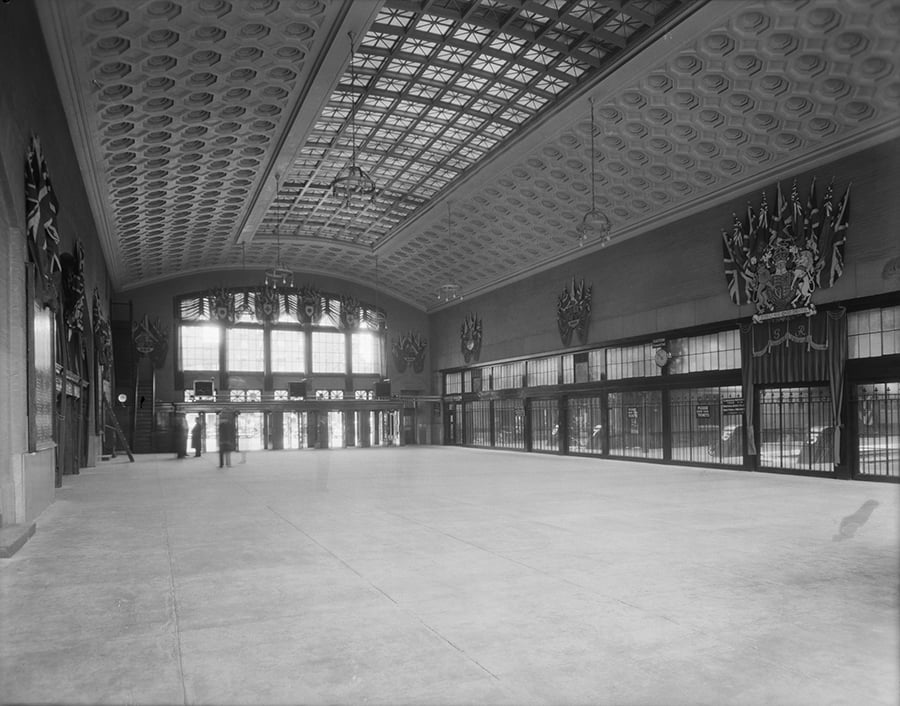
March 29, 2019
Diamond Schmitt Architects Adapts a Historic Train Station for the Canadian Senate
The project leverages the building’s opulent elegance, inserting strong nation-building imagery to create a new civic space and provisional home for the Senate.

The opening of Ottawa’s Grand Trunk Central Station in 1912 must have been quite the affair. Quickly assuming an important role in the rail-driven expansion of the young country, the imposing, symmetrical station came to signify Canada’s global ambitions, hosting foreign dignitaries like Queen Elizabeth and welcoming thousands of immigrants.
But the tides of history come and go, and the fervor of urban renewal in the ’60s banished the city’s rail functions to its periphery, rendering the station a functionless white elephant in the capital’s monumental core. It was repurposed as the Government Conference Centre, a role the Beaux Arts building never quite grew into. For decades, the government’s de facto multipurpose room languished, and throughout the 2000s various proposals sought to remedy the awkward situation, with little success.
An opportunity presented itself in 2014 as the Canadian government initiated a decades-long master plan to rehabilitate various buildings within the so-called Parliamentary Precinct. This required the Senate, Canada’s upper parliamentary house, to provisionally relocate. “The question was asked, ‘Could we go to the Government Conference Centre?’” recalls Thierry Montpetit, who, as senior director of Public Services and Procurement Canada, oversaw the Senate’s move. “I think it was serendipity.”

Veteran firm Diamond Schmitt Architects, with their joint-venture partner, KWC Architects, were tapped to oversee the adaptive reuse, which wrapped up in February, with a dual objective of maintaining the station’s opulent elegance and inserting spaces to accommodate the Senate’s functions. In the finished product, the project’s sensitivity, restraint, and ample Canadian imagery feel right at home in the culturally rich and politically important yet decidedly staid city.
“Very early on there was this quite clear idea of removing all of the elements that had obscured the original beauty and clarity of this building,” says Martin Davidson, a principal at the Toronto-based architecture office. The station was originally composed of five distinct volumes that progressively unfolded, but that layout was muddled to the point of illegibility over the years. Once the station’s axial layout and original processional route were clarified, certain interventions followed: What had been the station’s massive, vaulted concourse was the obvious location for the Senate chamber, and the grand waiting room was well suited for the insertion of three committee rooms topped by lounges. “All of those things actually aligned really well,” says Davidson. “It’d be great to take credit for it, but it fell into place in a really sympathetic way.”
Beyond elucidating the underlying layout, Diamond Schmitt saturated the Senate’s interiors with strong national imagery, communicating not only political import but a sense of Canadianness. “It was a very collaborative effort trying to find a narrative that could be purely Canadian and very representative of the country,” Montpetit says.

Those efforts resulted in a parade of Canadian symbols: maple leaves, flags, steam trains, Canada’s much-vaunted topographic diversity, and invocations of its cherished multiculturalism. Diamond Schmitt worked with Carleton University and Phil White, the Dominion Sculptor of Canada (“one of the best jobs in the world,” Davidson remarks), to hand-carve, 3D-scan, and fabricate the maple leaf motif, which turns up on doors, glass, wood carvings, and carpets.
A similar integration of old and new methods of fabrication characterizes the bronze perforated panels that delineate the committee spaces within the grand waiting room. Flanked by the station’s original stone Corinthian columns, they depict East and West Coast landscapes—scaled up from historical black-and-white photos—while a third panel shows a steam engine crossing a wooden trestle bridge.
With a formerly sequestered institution reopened to the public—and with the national imagery laid on thick—the inherently communal, public-facing functions of a train station feel restored. These synergies are not lost on the architects, who are proud to have revivified a shared national monument. “To give it a sense of place and volume really aligned with what train stations were about,” reflects Davidson. “They too were about monumental spaces and civic pride in a new world.”
You may also enjoy “In Lake|Flato’s Eco-Conservation Studio, Sustainability and Education Go Hand-in-Hand.”
Would you like to comment on this article? Send your thoughts to: [email protected]

















